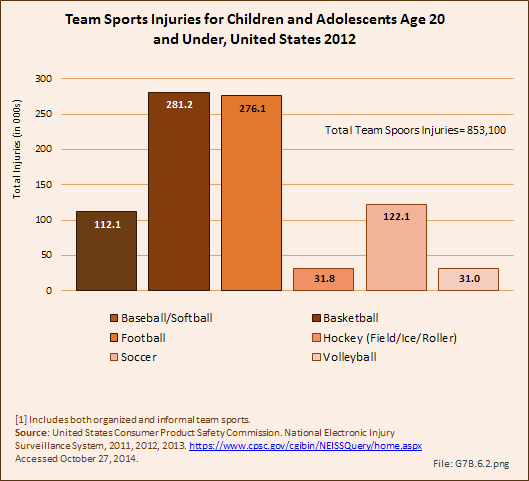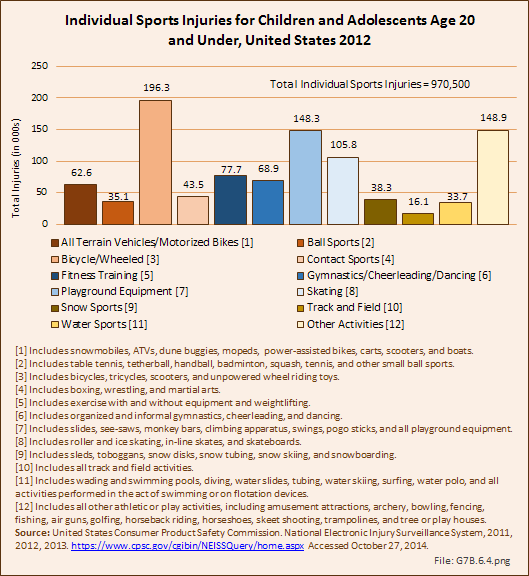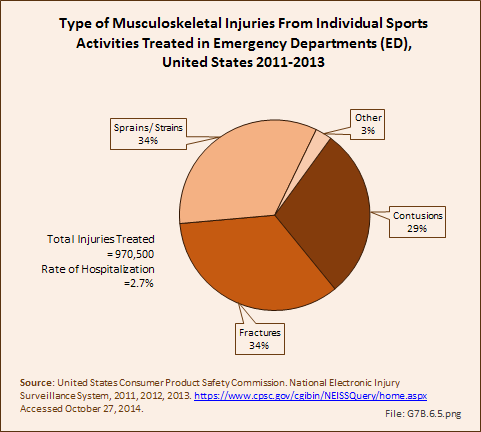

On average across the years from 2011 to 2013, 1.8 million injuries per year related to team or individual sport activities occurred to children and adolescents age 20 years and younger. Data reported is from consumer product-related injuries occurring in the United States from a statistically valid sample of emergency departments collected by the United States Consumer Product Safety Commission, National Electronic Injury Surveillance System. Data shown for sports injuries are not included in the overall total for musculoskeletal conditions among children and adolescents, on the assumption it duplicates numbers found in the emergency department database based on ICD-9-CM codes and used in the trauma injuries [3] section.
Males report injuries at twice the number as females, with the highest number of injuries occurring in the junior high (11 to 13 years) and high school (14 to 17 years) ages. (Reference Table 7.7.1 PDF [4] CSV [5])

Team sports, both organized and informal, accounted for just under one-half (47%, or 853,100 injuries) of all sports-related injuries reported. Basketball had the highest number of team sport related injuries at 33%, and was closely followed by football at 32%.
Team sport injuries to males were three times the number reported for females. The only sport in which female injuries outnumber male injuries is volleyball. Nearly half (45%) of team sport injuries to children and adolescents occurred during the high school years (age 14 to 17 years), with another 28% in the junior-high age range of 11 to 13 years. (Reference Table 7.7.1 PDF [4] CSV [5])

The most common musculoskeletal injury incurred was a sprain or strain, accounting for 46% of team sport injuries. Volleyball had the highest proportion of sprains and strains, followed by basketball. Baseball led in contusion injuries, while fractures occurred most frequently in football, hockey (including field, ice, and roller hockey), and soccer. (Reference Table 7.7.2 PDF [6] CSV [7])

Only 1% of team sport injuries were serious enough to result in hospitalization.
Individual sports injuries accounted for 53% of total injuries reported (970,500). One in five injuries occurred while riding bicycles or other nonmotorized wheeled equipment such as tricycles and scooters. These injuries occurred most frequently to children ages 6 to 10 years, but were common at all ages. Injuries on playground equipment were the second highest type of individual sport injuries, accounting for 15% of all injuries. Playground equipment injuries occurred almost exclusively to children age 10 years or younger. Skating injuries, which includes roller and ice skates, inline skates, and skateboards, were the cause of 11% of individual sport injuries.
Females accounted for a larger share of individual sport injuries (43%) than in team sports. Still, the only activity in which females had a significantly higher number of injuries than males was in gymnastics/cheerleading/dancing. (Reference Table 7.7.1 PDF [4] CSV [5])

Fractures and sprains/strains each accounted for one-third of all individual sport activity injuries. However, the type of musculoskeletal injury varied substantially with the type of activity. Fractures resulted from playground equipment injuries one-half the time, and there were a higher share of fractures in snow sports and skating injuries as well. Sprains/strains occurred in two-thirds of track and field injuries, and there were a higher share of sprains/strains occurring in gymnastics/cheerleading/dancing and fitness training injury category as well. The most common type of injury reported from bicycle/wheeled equipment were contusions. (Reference Table 7.7.2 PDF [6] CSV [7])

Nearly 3% of individual sport injuries resulted in hospitalization.
Links:
[1] http://www.ncys.org/publications/2008-sports-participation-study.php
[2] http://www.physicalactivitycouncil.com/pdfs/current.pdf
[3] http://www.boneandjointburden.org/2013-report/research-funding-care-and-prevention/vii3a-0
[4] https://bmus.latticegroup.com/docs/T7.7.1.pdf
[5] https://bmus.latticegroup.com/docs/T7.7.1.csv
[6] https://bmus.latticegroup.com/docs/T7.7.2.pdf
[7] https://bmus.latticegroup.com/docs/T7.7.2.csv